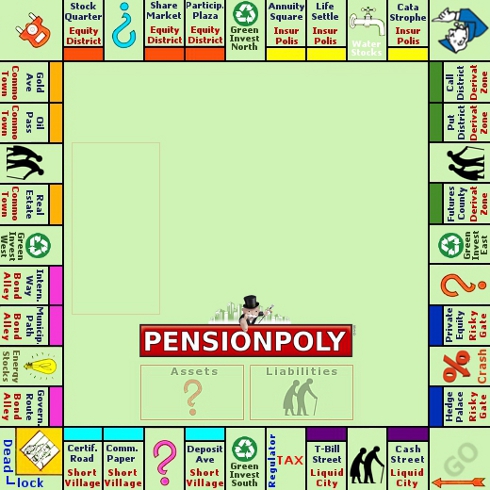Life Cycle Funds (LCFs) are seen as the ideal solution for pension planning. Unfortunately they aren't..... They're Second Best....
Pension Funds solutions (PFs), are far more superior to LCFs, as will be shown in this blog with regard to the performance of a pension plan.
As you come closer to the retirement age, you'll have to be more careful and decrease your stock portfolio incrementally to zero in favor of (assumed) more solid fixed income asset classes like government bonds.
A well known classic life cycle investment scheme is "100-Age", where the investment in stocks depends on your age. Percentage stocks = 100 - actual age.
E.g.: If you're 30 years old, your portfolio consists of 70% stocks and 30% bonds.
Here's what the average return of a life cycle '100-Age' investment looks like when you start your pension plan at the age of 30 and assume a long term 7% average yearly return on stocks and 4% on bonds.
The return of this life cycle fund is compared to a pension fund with continuously 50% in stocks.
Key question is however, is the younger generation also risk minded and the older generation risk averse?
As often in life and also in this case, what would be logical to expect, turns out just to be a little bit more complicated in practice....
Misunderstanding:Younger people have a high risk attitude
Research by Bonsang (et al.; 2011) of the University of Maastricht and Netspar shows that on average 25% of the 50+ generation is willing to take risk.
The research report shows evidence that the change in risk attitude at older age is driven by 'cognitive decline'. About 40 to 50% of the change in risk attitude can be attributed to cognitive aging.
Unfortunately other recent research also shows that only 30% of people under age 35 say they're willing to take substantial or above-average risks in their portfolios (source:Investment Company Institute).
This implies that - although they would theoretically be better of on the long run - younger people will certainly not put all their eggs in one basket, by investing all or most of their money in stocks.
Pension Fund Investment Horizon
In contrast to individual pension member investors, a pension fund has a long term perspective of more than 20-50 years as new members (employees) keep joining the pension fund in the future. Therefore a pension fund can keep its strategic allocation in stocks relatively constant over time instead of decreasing it.
This implies that a pension fund on the long term has an advantage (longer horizon) above a life cycle fund. Let's try to find the order of magnitude of this difference.
Comparing a Life Cycle fund with a Pension Fund
First of all, we have to take into account that younger people will not over invest in stocks.
Let's assume:
This leads to the next yearly return of these portfolios, as follows:
To find out the overall difference in return between LCF en PFS, we calculate the Return on Investments (ROI) of both investment schemes with help of the:
The outcome looks like this:
As you can see the ROI outcomes (left axis) on the investments (yearly contribution) from 'dying age' 65 to age 69 are negative as the cumulative payed pensions (compared to your contribution) didn't (yet) result in a positive balance. Or to put it in another way, if you die between age 65 and 69, you died too early to have a positive return on your paid contribution.
Overperformance
The right axis shows the difference between the LC ROIs and the PF ROIs.
As you may notice, the pension fund has a structural yearly overperformance of more than 0.3% and an average overperformance between 0.4% and 0.5% per year.
Overperformance expressed in pension benefits
Expressed in terms of yearly pensions the differences are as follows:
For a 40 year old pension plan starter, the differences are:
So..., Be wise and choose a pension fund for your investment if you can!
Aftermath
Of course, every pension vehicle has its pros and cons ... So do Life Cycle AND Pension Funds.....
Related Links/Sources
- CNNMoney:The young and the riskless shun the market (2011)
- Cognitive Aging and Risk Attitude (2011)
- America’s Comm. to Ret.Security: Investor Attitudes and Action (2012)
- “Saving/investing over the life cycle and the role of pension funds” (2007)
- Excel Pension Calculator Blog
- Benny AND Boone Comic Strips
- Study: Public employee pensions a bargain (2011)
Pension Funds solutions (PFs), are far more superior to LCFs, as will be shown in this blog with regard to the performance of a pension plan.
Life Cycle
A Life Cycle approach presumes that, while your young and still have a long time before retirement, you can risk to invest more than an average pension fund in risky assets like stocks, with an assumed higher long term return than bonds, As you come closer to the retirement age, you'll have to be more careful and decrease your stock portfolio incrementally to zero in favor of (assumed) more solid fixed income asset classes like government bonds.
A well known classic life cycle investment scheme is "100-Age", where the investment in stocks depends on your age. Percentage stocks = 100 - actual age.
E.g.: If you're 30 years old, your portfolio consists of 70% stocks and 30% bonds.
Here's what the average return of a life cycle '100-Age' investment looks like when you start your pension plan at the age of 30 and assume a long term 7% average yearly return on stocks and 4% on bonds.
The return of this life cycle fund is compared to a pension fund with continuously 50% in stocks.
Key question is however, is the younger generation also risk minded and the older generation risk averse?
As often in life and also in this case, what would be logical to expect, turns out just to be a little bit more complicated in practice....
Misunderstanding:Younger people have a high risk attitude
Research by Bonsang (et al.; 2011) of the University of Maastricht and Netspar shows that on average 25% of the 50+ generation is willing to take risk.
The research report shows evidence that the change in risk attitude at older age is driven by 'cognitive decline'. About 40 to 50% of the change in risk attitude can be attributed to cognitive aging.
Unfortunately other recent research also shows that only 30% of people under age 35 say they're willing to take substantial or above-average risks in their portfolios (source:Investment Company Institute).
This implies that - although they would theoretically be better of on the long run - younger people will certainly not put all their eggs in one basket, by investing all or most of their money in stocks.
Pension Fund Investment Horizon
In contrast to individual pension member investors, a pension fund has a long term perspective of more than 20-50 years as new members (employees) keep joining the pension fund in the future. Therefore a pension fund can keep its strategic allocation in stocks relatively constant over time instead of decreasing it.
This implies that a pension fund on the long term has an advantage (longer horizon) above a life cycle fund. Let's try to find the order of magnitude of this difference.
Comparing a Life Cycle fund with a Pension Fund
First of all, we have to take into account that younger people will not over invest in stocks.
Let's assume:
- A 30 year old 'pension plan starter', retiring at age 65
- Contribution level (€, $, £, ¥,): 1000 a year
- A long term 7% average yearly return on stocks and 4% on bonds
- Life Cycle Investment scheme
A modest 50% stocks, with a yearly 2% decrease as from age 50 - Pension Fund Investment Scheme
A constant 50% investment in stocks (and 50% in bonds) - Inflation 3%, Pension and Contribution indexation: 3%
This leads to the next yearly return of these portfolios, as follows:
To find out the overall difference in return between LCF en PFS, we calculate the Return on Investments (ROI) of both investment schemes with help of the:
The outcome looks like this:
As you can see the ROI outcomes (left axis) on the investments (yearly contribution) from 'dying age' 65 to age 69 are negative as the cumulative payed pensions (compared to your contribution) didn't (yet) result in a positive balance. Or to put it in another way, if you die between age 65 and 69, you died too early to have a positive return on your paid contribution.
Overperformance
The right axis shows the difference between the LC ROIs and the PF ROIs.
As you may notice, the pension fund has a structural yearly overperformance of more than 0.3% and an average overperformance between 0.4% and 0.5% per year.
Overperformance expressed in pension benefits
Expressed in terms of yearly pensions the differences are as follows:
| Investment Scheme | Pension at 65 | Relative |
|---|---|---|
| LC 55year -2% p/y | 11673 | 83% |
| LC '100-Age' | 12304 | 93% |
| PF 50% stocks | 13172 | 100% |
For a 40 year old pension plan starter, the differences are:
| Investment Scheme | Pension at 65 | Relative |
|---|---|---|
| LC 55year -2% p/y | 5359 | 82% |
| LC '100-Age' | 5578 | 92% |
| PF 50% stocks | 6040 | 100% |
Conclusion
Investing in life cycle funds ends up in a 7% to 18% lower pension than investing in a pension fund with 50% investment in stocks.So..., Be wise and choose a pension fund for your investment if you can!
Aftermath
Of course, every pension vehicle has its pros and cons ... So do Life Cycle AND Pension Funds.....
Related Links/Sources
- CNNMoney:The young and the riskless shun the market (2011)
- Cognitive Aging and Risk Attitude (2011)
- America’s Comm. to Ret.Security: Investor Attitudes and Action (2012)
- “Saving/investing over the life cycle and the role of pension funds” (2007)
- Excel Pension Calculator Blog
- Benny AND Boone Comic Strips
- Study: Public employee pensions a bargain (2011)






















































